Ancient art is the representation of stunning impressions and views of predecessors on art. The shape of it displays also the artistic talents of ancient artists, sculptors and other creative people of the epoch. Greek and Roman art is the theme for discussion in the paper. These kinds of art introduce a viewer or an observer into the domain of what was closer to Greeks and Romans in their evaluation of beauty and grace in a man and nature. The unique manner of the antique art characterizes the epoch and the rise of the Greek and Roman civilizations in the Mediterranean region. In this respect most features of this kind of art are considered with the historical development, social, political, and cultural events and, what is more, it is concerned with mythology. Mythological nature of Roman art encourages higher traits of character in most eminent people and shows the struggle or suffering of mythological heroes. The features of gods are included in the conceptual part of the art. The gorgeous theme is frequently interrupted with images of particular events and people. All in all, the details of Roman art are at a core of the discussion provided in the paper. In this respect the organization represents several sections that evaluate peculiar features of Roman art. The art, as it is, is the mirror of how people imagined the reality and how they adored it by the time prospects and the development of society.
First of all, it is vital to determine the schedule of the paper. The thing is that it is compiled out of three epochs or stages of art, namely: the Etruscan Art, The Archaic Greek Art, and Roman Art. Each of them represents a scope of sequential inheritance of forms and features which were signified in a new implementation by the next era in art. Notwithstanding, the Etruscan Art was primordially vital for the Roman civilization, as the source of impression and magnificence. In fact, having time limits of 1000-200 B.C. Etruscan succeeded in cultural, social, and political development (Ramage and Ramage 29). Etruscans were the forerunners who were apt at making their indigenous material culturally shaped with the originality and brilliance of execution. This period of art has much evidence. Most of them describe the works of ancient painters and sculptors. This particular implementation of artistic thought was successfully loaned by the representatives of Roman art. In this respect appears the truth that nothing which was in the past is forgotten in present. Romans in their barbaric manner for expansion were talented in this point of view. The example of the vase (see above) in Etruscan execution is made from clay, painted in terms of conquering theme, and incrusted with marble and bronze.
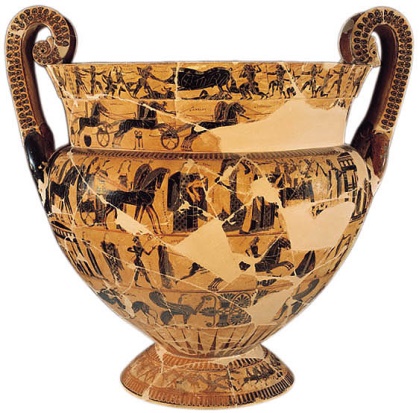
From the time of Romulus until the era of the Roman Empire the Roman Art gained also peculiarities of Greek Archaic Art. Thereupon, the conquering policy of Roman Empire presupposed also borrowing of all artistic techniques and methods which are relevant to Roman preferences. Greek masters of art in painting, sculpture, and architecture and their works were of great concernment for Romans. In fact, the Roman Art in most points is closer to Greek Art than to Etruscan: “Accordingly much of what we know of Greek art comes from Roman interest and through Roman interpretations” (Griffiths 33). The ideals of masculinity were similar in Greek and Roman art. Hence, the motivation to describe the military subjects or the episodes in wars was at a core of the art. Thus, the motives of war and divine support in such actions were apparent in both Greek and Roman Art. In fact, for ancient Greece art was a means for visual communication (Osborne 12). It could then influence the oral or written communication. Greeks were interested in the beauty of their cities. The architecture of Ancient Greece was illuminated with sculptures and paintings. This is why the tripartite alliance of three kinds of art characterizes Greek Art. The theme of masculinity then made additional impacts on the Roman Art. The example shown above is the scene from Greek Spartan warriors. It estimates particularly the tone and the motives of Greek Archaic Art.
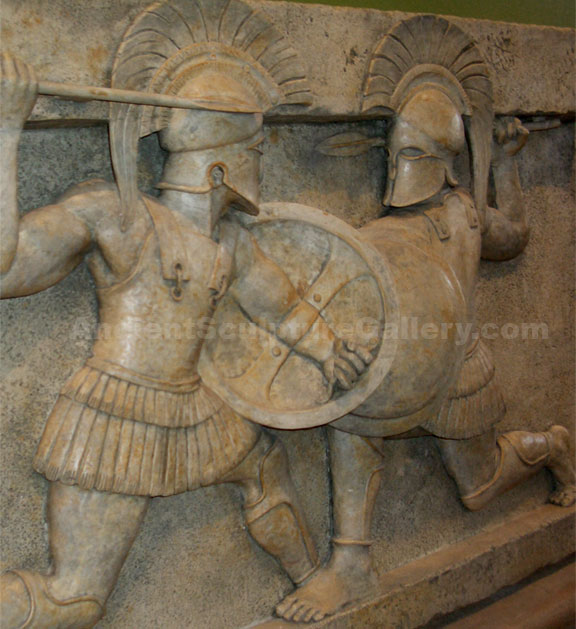
Looking at both Etruscan and Greek Archaic Art it is necessary to mention that Roman Art was the unification of the best achievements of these in terms of motives, techniques, materials, and other features. The Romans were known for their ability to better use current ideas of civilizations in art than to find out the new ones. The art and culture of Classical and Hellenistic Greece captured special attention of Romans: “A great wave of Greek influence in Rome began in the mid-second century BC with the conquest of Greece, and lasted well into the first century” (Walker and British Museum 14). All in all, the main themes in the art of Rome from the later republic to the early Empire included the most vital ones. Some among them are: love, women, heroes, gods etc. Moreover, the art touched upon the social and political elaboration of the society. The works of art reflected the social markers of their owners. The importance of decoration and ornamenting also depicted the grace and magnificence of Greek and then Roman Art. The traditional background of beliefs and rituals for the representatives of antique art was a point of central implementation in art. Paintings described the visual reality of the epoch. Sculpture displayed such visual objects but with particular shapes in stone. Architecture was a domain of higher impression among Greeks and Romans due to its practical use it. Ancient theater represented human participation in action. Most of plays in Greek and Roman Theater were based on mythological episodes or stories. All these features of Greek and Roman Art were greatly exemplified by the contemporary creative people.
One of the major themes in the ancient art was the theme of love. It is logical to suppose that the patroness of love in Roman Empire was Venus (the analog of Aphrodite in Ancient Greece). In this respect the love was considered, as one of the main mysteries of life for ancient people. Furthermore, the artistic implementation of love episodes projected the figure of Venus in form of a bust or full-size statue. Roman artists tried to implement the elements of love through the mythological episodes. In this case the mythological heroes were the etalons of how a man should behave when this highest feeling occupies his/her soul. The theme of love has something in common with the figure of a woman.
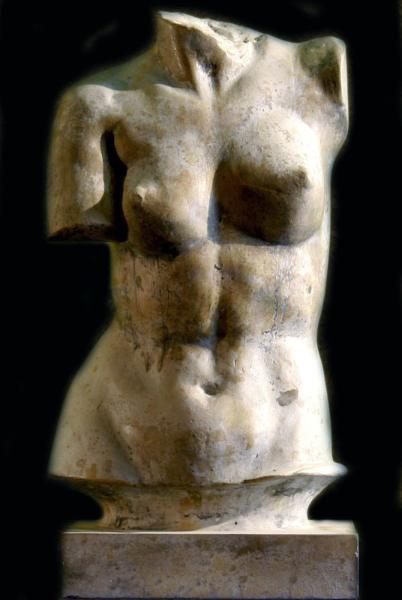
The motives of a woman’s body were particular for ancient Romans. Artists and sculptors tried to deify a beauty of a woman’s body. Such motives supposed the nudity, as the main feature in representing the real grace. Nudity was a feature of Greek culture and art. In fact, in this approach there was not only direct reasoning about beautiful, but also a comparison to the transparent life of the society: “Among the innovations of the ancient Greeks that changed our way of seeing the world, one of the most prominent is a certain kind of public nudity – nudity as a costume” (Bonfante 543). Romans borrowed this perspective from Greeks, but they used it not so frequently in the art. However, Romans were great lovers of entertainment and food. This is why the fleshy pleasure was in most points considered among them with the figure of a woman. In most cases artists tried to please by means of this theme those who ordered pictures, sculptures or architectural incisions in the form of a naked woman. This feature of antique art was the key aspect for Romans and Greeks. They tried to make more emphasis on the positive cultural elaboration in the ancient society. The human civilization still admires the works of ancient masters which are available today in many museums and galleries worldwide. Notwithstanding the neglect of a woman in the society where men were prior and dominant, Greco-Roman art signified the person of a woman, as a symbol for hope and mercy. The research showed that ancient artists and sculptors followed the urge of the beliefs and the symbol of Victory was compared to a woman (Kleiner 244). Furthermore, the statue of Victory, as a woman, was also patterned with a palm branch in her hand. Such parallels were significant for Romans. Woman was a symbol for something new and glorious for Romans.
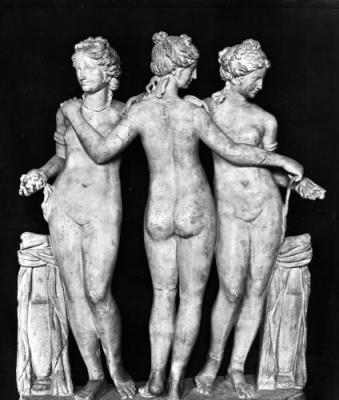
The paramount role of religion and mythology was taken into account by the ancient artists. On this background the most of the pictures, sculptures, and architectural works were done. In terms of the mythology, as was mentioned above, the dramaturgy urged for the attention of a viewer. The philosophical thoughts of Epicurean and Stoic schools were arranged also in terms of religious prospects. Thus, visual arts, dramaturgy, and literature were based in ancient Rome according to the gorgeous subjects. In this respect the architectural and sculptural lines in Roman art were eagerly sought. The thing is that Romans tried to please their 12 most powerful gods. They placed their images and statues in temples, on the squares and in private houses of the Roman aristocracy. The building of Pantheon, the place where all gods were gathered for worshipping, was the eminent example of ancient architecture. The divine design of this building demonstrates the constructivism with which Romans took it. The highest priority of gods was centered in each part of artistic work among both Romans and Greeks. Romans thoroughly followed the traditional submission to the will of gods in every area of everyday life. Thus, Pantheon is another example of deity motives in art of ancient Rome. It is the place where all three major kinds of art (painting, sculpture, and architecture) were implemented serving for one idea.
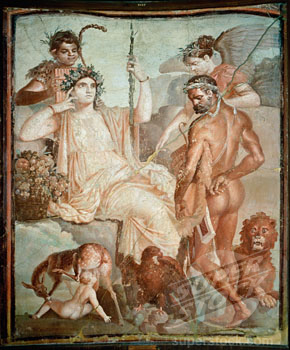
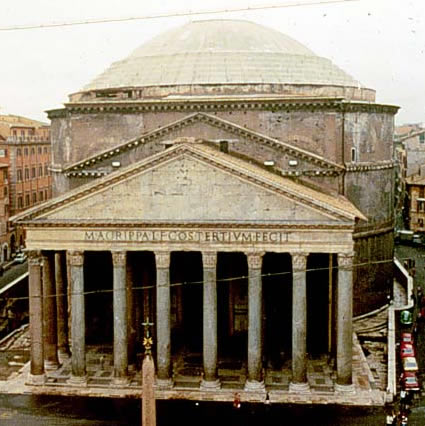
Being a cradle for the growth of political thought, Rome comprised a lot of works by ancient artists devoted to the description of Roman Emperors. Not only Emperors but also other eminent social figures, as the philosophers, dramatists, heroes in war were described in the art. This flow of artistic thought had the initial idea to provide a scope of talents and features of character in the person of a man. For instance, the statue of the Emperor Augustus the features of mastership in reigning such a wide-spread country, as the Roman Empire, is patterned with different carvings and artistic molding. When looking at this sculpture, the details on Augustus’s dressing represent his gorgeous nature and relation to gods. Even a sculpture of Amur supports this idea. All in all, the sculptor of this work masterly implemented the ensemble of material (marble), shapes, forms, and gestures by Augustus. His person symbolically discovers the achievements of the Emperor and his ability to increase the territorial authority of the Roman Empire. The bust of Marcus Agrippa is similar to statue of Augustus in the technical implementation. Tin this case the magnificence and glory of the ruler should express the straightforwardness of his look with seriousness on his dace. This logically made the subject matter for a sculptor easier. However, one should not state that the Roman Art is indigenous in its particular performance and in the way the Roman masters used techniques and approaches when making a masterpiece. The art of Greece was the major impulse for the formation of Roman art: “Greek sculpture flourished in the round, in free-standing reliefs, and in architectural formats; artists worked in limestone, marble, bronze, other metals, bone, ivory, terracotta, and more exotic media (like faience), and combinations such as gold and ivory” (Griffiths 33). A researcher can apparently admit suchlike methods in sculpture among Roman masters. Thus, the political and social theme was relevant to Greco-Roman art.
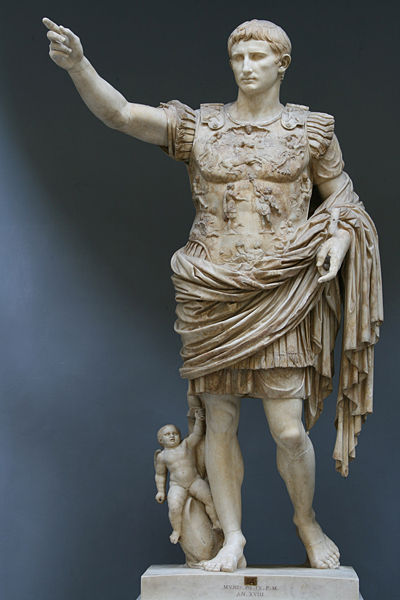
Theater was another side of artistic thought in Rome. It was the place where the art of drama was reproduced owing to emotionally colored play of actors. Theater depicted the mythological, social and political issues in Rome which were previously arranged and apprehended in the literature, painting, and sculpture. Theatrical essence was highly reflected by ancient Romans. It was mostly due to the plays of Greek dramatists, such as Sophocles. In this respect Romans acquired the manner of theatrical performance and play of actors in plays from the Greek theater as well. The use of no decoration was particular for the stage. The necessity of masks for male actors who played female parties was also borrowed from the Greek theater. However, Romans insisted on the true originality and indigenous nature of their art (Gedacht 22). This is why the masters of the Roman theater were applied to the Roman reality about art owing to the warfare power of the Empire and the commands of the highest officials in the Roman society. In this respect it is also important to note that the top of the society followed the trendy flow for art in its every form and kind. Art served, as the marker of class division in the Empire. Rome was the center of suchlike fashionable tendency. In ancient theater within the audience, one may simply meet the members of the Senate and other most significant for the time persons. Hence, the art was the way for communication between Romans, as it was primordially in Greece. On the other hand, when analyzing the picturesque architecture of Roman theaters along with the mythological implementation in literature, it is vital to admit that drama was the reflection of several kinds of ancient art in its unique shaping. The enormous width of the Roman possession presupposed its use of every cultural and traditional peculiarity of other subordinate countries. In this case the theater was particular only for Greece. However, the Romans tried to make something new for the art mastership that could then designate their peculiar mastership. They involved the technique of mime, actions in the theater without words (Gedacht 22). Roman Art became more distinctive due to its symbiosis of the universal arts and best achievements of it at the time.
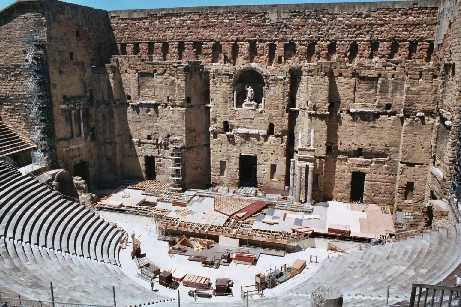
One more feature of Greco-Roman art is the importance of decoration of pictures, frescos, and vases or amphorae. This feature of ancient art introduces an observer to the meaning of precious things such as gold, marble, ivory etc. Each material besides its applicability in the picture or vase also described the intentional complex of qualities that were supposed with religious aspects. Gold was a symbol, of prosperity, marble – magnificence and firmness (Kleiner 145). This is why the art and the meaning went in Roman culture side by side. There was nothing spontaneous or lacking in sense in the Roman art. This field of the heritage of mankind continued developing the most significant amenities of Etruscan, Archaic Greek and Hellenistic art.
…those who deal with the remains of the classical civilizations of Greece and Rome have one great advantage over those who work in other areas: they have at their command a great wealth of evidence concerning the civilizations with which they are dealing in the writings of the ancients themselves (Biers 13).
This general evaluation of the ancient art provides a sophisticated outlook on the main values of humanity, aesthetics, love, duty to the country and others which are stated today, as paramount. In fact, Roman art gave several stimuli for the Western civilization. It was highly reflected in the epoch of Renaissance. Its traces are still obvious in the outskirts and central part of Rome and in museums around the world.
To conclude, the trend of the artistic thought in ancient (antique) world is supposed with impacts on Etruscan world and its implementation in different pieces of evidence. Vases, sculptures, and cultural and religious scriptures of these ancient people are delivered till present day. The significance of Greek art is also outlined with ancient flow of civilization. It was growing due to the rise of human potential. In most points researchers relate this with the religious aspects of ancient Greeks and Romans. At la7st the Roman art is the representation of Etruscan and Greek arts made in terms of new themes and characters. Such a fair notion is logical because of the straightforward warfare of Roman Empire since the time of republic. Painting, sculpture, architecture, and theater were among the most popular kinds of art. Each of them described the attitudes of Romans toward religion, myth, concepts of woman, and love. Moreover, devotion of a man to art in the ancient world was also considered with his noble and powerful position in society. All in all, Roman art served as catalysts to further the development of humanity. Its achievements now represent a huge part of the world’s artistic heritage.
Works cited
Biers, William R. The Archaeology of Greece: An Introduction. Ed. 2. New York: Cornell University Press, 1996.
Bonfante, Larissa. “Nudity as a costume in classical art.” American Journal of Archaeology 93 (1989): 543-570.
Boardman, John Griffin, Jasper and Murray, Oswyn. The Oxford illustrated history of Greece and the Hellenistic world. Oxford: Oxford University Press, 2001.
Gedacht, Daniel C. Art and Religion in Ancient Rome. New York: The Rosen Publishing Group, 2004.
Griffiths, John. “Greek Art” The Art Institute of Chicago, 1994.
Kleiner Fred S. Gardner’s Art Through the Ages: The Western Perspective. Ed. 13,Stamford, CT: Cengage Learning, 2009.
Nancy H. and Ramage, Andrew. Roman Art: Romulus to Constantine. Ed. 5. New York: Prentice Hall, 1995.
Osborne, Robin. Archaic and classical Greek art. Oxford: Oxford University Press, 1998.
Petersen, Lauren Hackworth. The Freedman in Roman art and art history. Cambridge: Cambridge University Press, 2006.
Walker, Susan and British Museum. Roman art. Cambridge: Harvard University Press, 1991.
